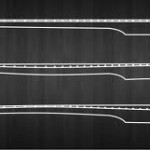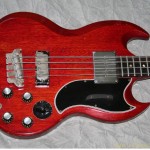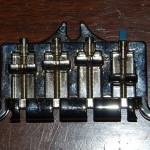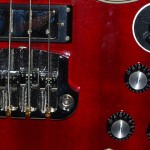Archive for November 27th, 2013
In my continued search through a plethora of guitar parts on the market I will need to address the next issue on this new Epiphone Custom Shop EB3 bass, (or as I search for bass bridge parts I might refer to this as the Epiphone SG bass) and that is intonation. So now we are getting in to the set up phase of making this bass rock! First, I lowered the bridge to the point where they cleared the upper frets without choking and fretting out and also still rang clearly. Now in the lower fret area I saw that there was more “relief” or upper curvature that I like and felt there was room there to get the strings a bit closer to the fingerboard. Off comes the truss rod cover, insert the truss rod wrench and very slightly turn clockwise checking between increments. As the truss rod is adjusted in this fashion, the relief is lessened, the neck becomes flatter and the strings get closer to the fingerboard resulting in lower more comfortable action. What I want is to get the playing action as close and effortless as possible while also allowing the strings to ring out clearly. When the strings are high they ring out clearly. When they are too low they become stifled and somewhat dead in sound, and also quite often buzz. My goal is to reach that particular “sweet spot” in between these polar opposites that gives me the best of both worlds; comfortable playing action and great tone.

Trying to get to get the bass strings as close as possible while still allowing them to ring out requires minimizing relief but avoiding back bow on the Epiphoine EB3 or Epiphone SG bass.
After a few tweaks of the truss rod of about an eighth of an inch each time, I get there. Doing a test run, it plays really good, but after tightening the truss rod, I have a little buzzing on frets 19 and 21. Feeling that they may need to be filed and dressed, I resist the urge and let the bass sit for two days after the neck adjustments. This is a good idea because we are dealing with wood. By tightening the truss rod, I increased the tension and stress on the neck. Quite often after getting things really nice, you can come back a day or two after to find out that the neck responded more than you might have anticipated leaving you with less than ideal relief, in which case you have to go back in and readjust in the other direction to lessen the tension and bring the neck back to where you wanted it.
Sometimes you have to repeat the process, sometimes not. Like I said it is wood and that leaves a percentage of uncertainty with respect to truss rod adjustments.
As it turned out, there was no change at all after a couple of days. Out came the fret files. This can get tricky as you will see. I stated that frets 19 and 21 were buzzing just a bit. First I cleared fret 19 by slightly taking down fret 20. Good so far, well not exactly because fret 20 was now buzzing against 21 where it wasn’t previously. Now I take down fret 21 and all seems pretty good except for just the slightest buzz of fret 21 against fret 22. A slight filing of 22 corrects this. Then I get my fret dressing and polishing kit out to smooth down the areas where I adjusted and leave a mirror like surface once again. Nice action, clear bell like tones. Cool. Apply a thin coat of lemon oil to the fingerboard, work it in, buff it out.
The lesson to be had from this is that when you eliminate a buzz somewhere on the fingerboard, often afterward, you start to chase that buzz all the up the fingerboard. In this case when fret 19 buzzed against fret 20, I ended up filing all the way up to the last fret to get it right. So you have to be careful, VERY careful not to overdo it, especially if you have a problem much lower down the neck. You have to be very patient and make very slight adjustments when filing a fret, constantly checking and rechecking. You can easily take away height but if you’ve gone too far, you have a potential nightmare on your hands. So if you are ever inclined to do this to a guitar, grab yourself a cold Miller 64, sit back for a few minutes and enjoy, then really consider whether you are up to the job. If you have never done any fret work or set up work you might want to consider acquiring a nice cheap guitar on Ebay and hone your skills a bit before you go out and start messing with one of your keepers, or let an experienced tech do the job for you. I have been doing this for a long time and I still have some dicey moments that I start to cut a sweat over. So far, knock on guitar neck, no disasters.
Next intonation check. Everything is within normal limits and sounds good except for the G string. The 12th fret octave is noticeably sharp of the harmonic. What to do? In order to bring the octave down you have to increase the overall string length between the bridge and the nut. I then adjust the bridge saddle so that it is further away from the nut. I do this until the 12th fret octave rings true with the harmonic. Now there is another problem. As it turns out, the more the saddle is adjusted away from the nut, the closer the string becomes to the neck. With the intonation adjusted properly, the G string is too close to the neck and fretting out. It should be a simple fix, right? Simply raise that saddle until the string height falls inline again with the other strings. Problem is, Epiphone and well as the Gibson EB3 have only a two way adjustable bridge. You can adjust the entire bridge in terms of height and the bridge saddles individually in terms of intonation but you cannot adjust the individual saddles for string height. This really sucks, especially when I am now so close to reaching “set up Nirvana”.
What can be done. I can adjust the bridge as a unit to where the offending G string sits properly which would make the other strings unacceptably high, and then file down the remaining saddles until they all line up with this SOB of a G string! Extremely labor intensive to incrementally file a steel bridge saddle until it matches and then do it two more times while making sure that the intonated spot on the saddle adjustment screw is not altered. I think I’d rather experience Chinese water torture than go through that. So throwing my hands up in the air I came up with a quick effective but very cheesy fix. I took out a fat rubber band from my junk drawer that was used previously to hold a lobsters claw closed. I am sure you know the type. Small diameter, wide, and thick. I cut two vertical slices from the rubber band and place one under the G string saddle to raise it. Not bad, but not enough. Add the second slice and that does it. I have raised the saddle with two chunks of rubber. Not very elegant and I am not really happy about this but is effective for the time being and does the job.
In the meantime I sort through as many guitar blogs and guitar parts blogs and websites for Epiphone Bass Parts as I can find relative to this problem. Honestly, I think this is a design flaw and both the Gibson and Epiphone bridge are pretty much the same. In fact, the original Gibson EB3 bass didn’t even have intonatable bridge saddles but simply a raised berm on the bridge to approximate where everything might be correct. 2 way adjustable is bad enough. That must have stunk even worse considering the the only adjustment possible was to raise or lower the bridge height only as a unit!

Gibson EB3 Original One Way Adjustable Bridge Not very adjustable at all! One size fits all intonation!

Epiphone stock 2 way adjustable bass bridge. Note lobster claw rubber band segments for G string height adjustment. Yipes!
Oh well, that’s life I suppose… Then I happen to come across what might very well be the solution!!! Noodling around Ebay I see something that is the answer and the second easy mod that will make this bass ROCK! It is called the HIPSHOT Supertune Bass Bridge. For further information click on this link:http://store.hipshotproducts.com/cart.php?m=product_detail&p=264
This is a direct no modification replacement 3 way adjustable bridge for Gibson and Epiphone EB3 basses. Looks like EXACTLY what I want!. Ch-ching! Add another $89.00 to the cost of admission but if this mod, like the Rothstein varitone circuit can make a significant improvement on an overall excellent platform it will be worth the investment and so I do a BIN ( Buy It Now ).
The following week the bridge arrives and the install goes smooth as silk taking me seriously about five minutes for the basic install. I tune up to pitch and do a quick adjustment of individual string heights!! Yay!! INDIVIDUAL adjustment!!! The bridge saddles are similar to what you would find on a typical Fender Sratocaster or Telecaster having twp set screws for height adjustment; one at either end of the saddle. Then I adjust all the 12th fret octaves to ring true to their respective harmonics and do a final height adjustment
on all the strings. Wonderful, this bridge totally works, is a beautiful addition, and is built like a tank. Final tune up, plug into my Ampeg B-15R and this bass plays and sounds spectacular. This new chunk of steel bridge really seems to improve the depth and sustain as well and it does make sense. Instead of the old bridge suspended over the top of the bass by three bolts, this bridge is clamped flat against the top by two bolts. The entire bridge assembly rests right on the bass. This Epiphone EB3 bass plays so well now, I really cannot see how one with a Gibson name on the headstock could outdo it!!
Next up; 3 easy mods to make your Epiphone EB3 Bass GREAT! The Finishing touch!
